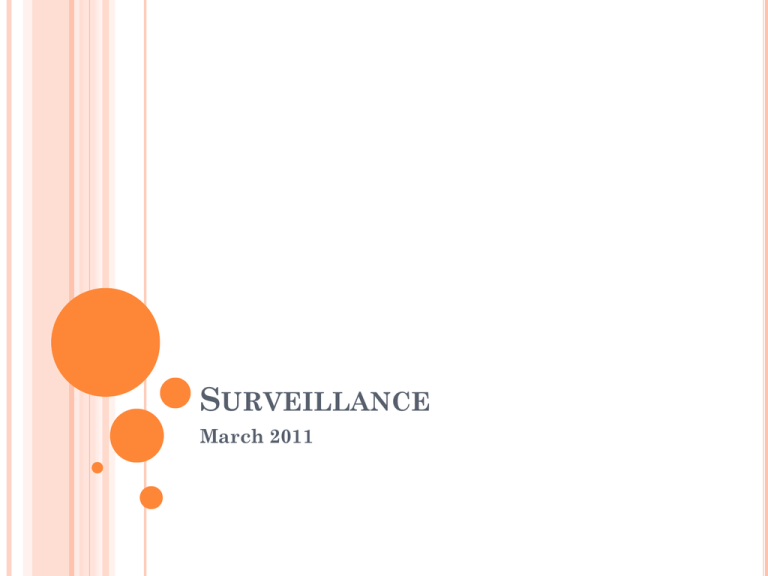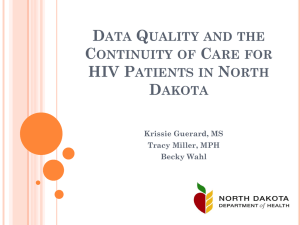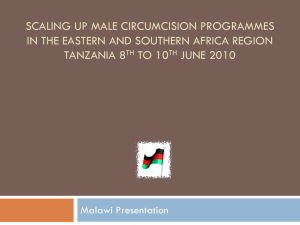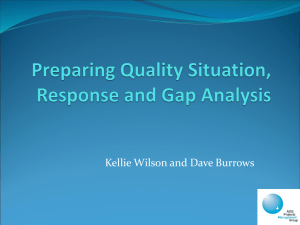
SURVEILLANCE
March 2011
SESSION
Definition
Conditions
Types
Methods
Recommendations
DEFINITION
An ongoing systematic collection, analysis,
interpretation, and dissemination of health data
An ongoing exercise of continuos scrutiny
and watchfulness over the distribution and
spread of diseases plus related factors with
sufficient accuracy and completeness to
provide basis for effective control by the
appropriate authorities responding and
acting so that health of communities are
protected.
WATCHFULNESS-CLOSE OBSERVATIONS
Quarantine
Personal surveillance
Public health surveillance
DETECTION
THE RESPONSE
EPIDEMIC STATES
Endemic
Epidemic
Pandemic
Low level: Prevalence less than 1% in any sub group in
population.
Concentrated: - Prevalence consistently over 5% in at least
one defined sub population.
- Prevalence below 1% in pregnant women in
urban areas
Generalised: Prevalence between 1-15 % in ANC population
Hyperendemic: HIV prevalence exceeds 15% in adult population
JUSTIFICATION
Disease must be important
Surveillance necessary to guide, monitor and
evaluate prevention
surveillance necessary to establish baseline
incidence
For a new disease to learn about pattern of
occurrence, clinical pattern and risk groups
available or alternative sources of data not
sufficient
TYPES OF CLASSIC SURVEILLANCE
Active
Passive
Sentinel
Surveillance system based on secondary data
analysis
Facility based
Community based
SENTINEL SURVEILLANCE
is the collection and analysis of data by designated institutions
selected for their geographic location, medical specialty, and ability to
accurately diagnose and report high quality data.
For example, district hospitals may be required to report specific
conditions such as bacterial meningitis in order to quantify the
burden of disease due to Haemophilus influenzae type b.
Generally, sentinel surveillance is useful for answering specific
epidemiologic questions, but, because sentinel sites may not represent
the general population or the general incidence of disease, they may
have limited usefulness in analyzing national disease patterns and
trends.
USAID
DEFINITION
Strengthened systems in an increasing number of settings to
monitor the biological and behavioural indicators of the
epidemic.
Monitors risk behaviours, to warn of or explain changes in
levels of infection.
Uses data from behavioural surveillance to interpret data
gathered from sero-surveillance efforts.
Tailored to the type of epidemic - no "one-size-fits-all"
surveillance system
- In generalized epidemics
- In concentrated epidemics
-In low-level epidemics
GOALS OF SECOND GENERATION SURVEILLANCE
Better understanding of trends over time
Better understanding of the behaviors driving the
epidemic in the country
Surveillance more focused on sub-populations at highest
risk of infection
Flexible surveillance that moves with the needs and
state of the epidemic
Better use of surveillance data to increase understanding
and to plan prevention and care
DATA COLLECTION METHODS
Biological
Behavioural
Other sources
BIOLOGICAL
Sentinel serosurveillance in defined sub-populations
Regular HIV screening of donated blood
Regular HIV screening of occupational cohorts or other
sub-populations
HIV screening of specimens taken in general population
surveys
HIV screening of specimens taken in special population
surveys
BEHAVIOURAL
Repeat cross-sectional surveys in the general
population
Repeat cross-sectional surveys in defined subpopulations
Other Sources
•HIV and AIDS case surveillance
•Death registration
• STI surveillance, TB surveillance
SURVEILLANCE CAPTURES….
Biological indicators
HIV prevalence
STI prevalence
TB Prevalence
AIDS cases
Behavior indicators
Sex with non-regular partner in
the last 12 months
Condom use at last sex with a
non-regular partner
Youth: Age at first sex
Sex workers: Reported number
of clients in the last week
Social Demographic indicators:
Age, Sex , marital status, Social economic,
including education, residence, parity,
PRINCIPLES OF 2G SURVEILLANCE
•Be appropriate to the epidemic state
•Be dynamic change with the epidemic
•Use resources where they will generate most
useful information
•Compare biological and behavior data for
maximum explanatory power
•Integrate information from other sources
•Use data produced to increase and improve the
national response
3RD GENERATION SURVEILLANCE
Third generation surveillance adds value to
second generation surveillance by measuring
coverage and quality of care for People Living
With HIV/AIDS (PLWHA) and STI patients.
Provide a better Understanding of sexual
behaviours and risky practices driving the HIV
epidemic
Assess trends and status over time
Orient public health actions towards the most
vulnerable groups, the stigmatised and
marginalised
Camara, 2003
3RD GENERATION -3 COMPONENTS
Epidemiological Surveillance:
HIV, AIDS, AIDS Deaths, & STI case reporting
Prevalence and anti-microbial resistance surveys (HIV and
STI)
Knowledge, Attitudes, Beliefs and Practices (KABP)
or Behavioural Surveillance Surveys:
Periodic BSS or Knowledge, Attitude, Beliefs and Practices
(KABP) and seroprevalence surveys among vulnerable
groups (i.e., Young People, FSW, MSM, People Living with
HIV/AIDS)
Periodic BSS or Knowledge, Attitude, Beliefs and Practices
(KABP) household-based surveys (e.g. during DHS
surveys)
Specific Periodic BSS surveys among the most vulnerable
groups (burden and spread of the epidemic) be conducted
with their valuable input (Young People, MSM, FSW and
PLWHA)
COMPONENTS CONT..
Audit of quality of treatment and care for PLWHA
and patients with Sexually Transmitted Infections:
Universal Case Reporting
Sentinel Surveys and Reporting
Repeated cross-sectional surveys: seroprevalence,
behavioural, etiologic & anti-microbial resistant patters
Other Qualitative and Quantitative Special Surveys among
vulnerable groups
Active Surveillance
Passive Surveillance
Registries
Cohort studies among PLWHA to Audit Quality of Care &
Treatment provided to that population group
Exit Surveys among STI patients (Health Facility Survey)
Observational studies
DATA SOURCES FOR 3RD GENERATION
Validating AIDS death using the vital statistic
registries from Central Statistics Offices,
HIV screening data from visa and job applicants,
pre- employment HIV testing, and insurance
applicants, among others (Camara, 2003).
RECOMMENDATIONS
Should security systems be the same
One size fits all
LOW LEVEL
Principles:
Prevalence < 1%
HIV infection may have existed for many years,
but never spread to significant level in any sub
population
Infection largely confined to individuals with
high risk behaviours (e.g. CSW, Drug injectors,
men having sex with men)
- the epidemic state suggests diffused
network
of risks, or virus introduced only very
CONCENTRATED
Principle:
Prevalence high in one or more subpopulation
HIV spread rapidly in a defined population, but not in
the
general population
Epidemic state suggests active net work of risks within
the sub-population
Future trend determined by nature of links between
highly infected sub-population and the general
population.
Numerical proxy:
- Prevalence consistently over 5% in at least
one defined sub population.
GENERALISED
Principle
Prevalence between 1-15% in ANC
population
HIV firmly established in the general
population
Sub-population at high risk continue
disproportionately continue to spread the disease
Sexual networking sufficient to sustain an
epidemic independent of sub-population at high
risks
Numerical proxy: HIV prevalence consistent
HYPERENDEMIC
HIV prevalence exceeds 15% in adult population
Driven by heterosexual multiple concurrent
partnerships
Low level and inconsistent condom use
All sexually active adults are at elevated risk of
HIV infection
RECOMMENDATIONS: LOW LEVEL
Cross-sectional surveys of behavior
in sub-population with risk behavior
Surveillance of STIs and other
biological markers of risks
HIV surveillance in sub-population
at risks
CONT
Tracking of HIV in blood donors
HIV program coverage disaggregated by pop
subgroups
RECOMMENDATIONS FOR M&E
CONCENTRATED EPIDEMIC
HIV and behavioural surveillance in sub-populations
with risk behaviour and analyse context and drivers
of predominant risk behaviour
HIV and behavioural surveillance in bridging groups
Cross-sectional surveys of behaviour in the general
population
HIV sentinel surveillance in the general population,
urban areas
Periodic National assessment of national response
RECOMMENDATIONS FOR
GENERALIZED EPIDEMIC
Sentinel HIV surveillance among pregnant woman,
urban and rural
Cross-sectional surveys of behaviour in the general
populations
Cross-sectional surveys of behaviour among young
people
HIV and behavioural surveillance in sub population
with high risk-behaviour.
Data in mobility and mortality
HYPERENDEMIC
Conduct additional behavioural and
ethnographic studies ( young people, girls,
married men ) to map and define sexual
networks
All actions above for other scenarios
THE END
Watchfulness
Share the data
share the responsibility
share the credit
REFERENCES
1.
World Health Organization and UNAIDS. Second generation surveillance for HIV: compilation of
basic materials. CD-ROM. Geneva, World Health Organization (WHO/HIV/2002.07).2002
2.
World Health Organization and UNAIDS.Initiating Second Generation HIV Surveillance Systems:
Practical Guidelines. Geneva, World Health Organization (WHO/HIV/2002.17). 2002
3.
World Health Organization and UNAIDS. Guidelines for Second Generation HIV Surveillance for
HIV:The Next Decade. Geneva, World Health Organization (WHO/CDS/EDC/2000.05). 2000
4.
World Health Organization and UNAIDS. AIDS Epidemic Update: December 2002. Geneva, World
Health Organization(ISBN 9291732532). December 2002.
5.
World Health Organization and UNAIDS. Report on the Global HIV/AIDS Epidemic 2002. Geneva,
World Health Organization (ISBN 9219731854). July 2002.
6.
UNAIDS Best Practice Collection. Trends in HIV Incidence and Prevalence: Natural Course of the
Epidemic or Results of Behavioral Change? Geneva, UNAIDS (UNAIDS 99.12e). June 1999
7.
UNAIDS Best Practice Collection. Connecting Lower HIV Infection Rates with Changes in Sexual
Behavior in Thailand: Data Collection and Comparison. Geneva, UNAIDS (UNAIDS 98.15). June
1998.
8.
UNAIDS Best Practice Collection. A Measure of Success in Uganda: the Value of Monitoring both
HIV Prevalence and Sexual Behavior. Geneva, UNAIDS (UNAIDS 98.8). May 1998.







